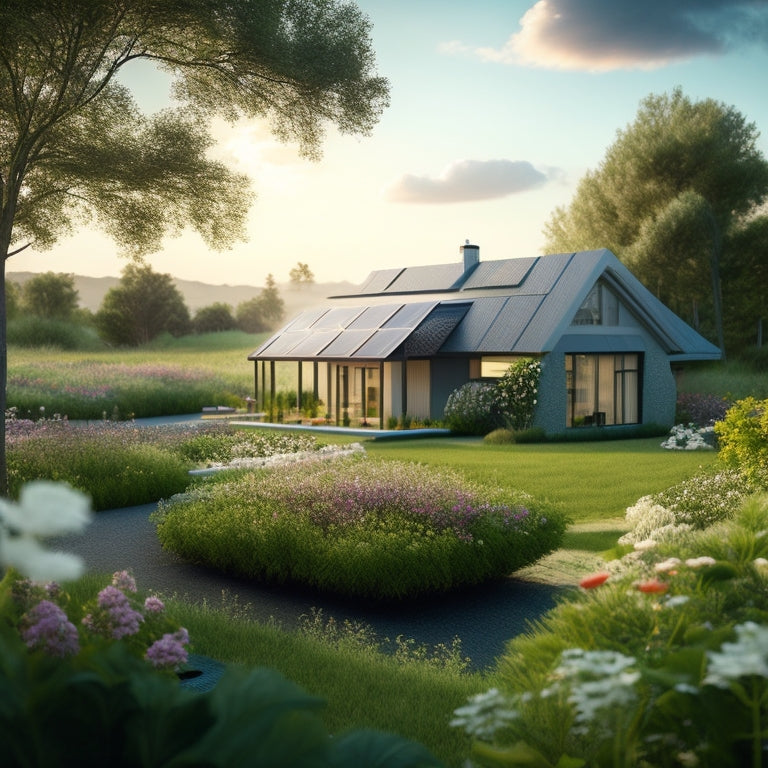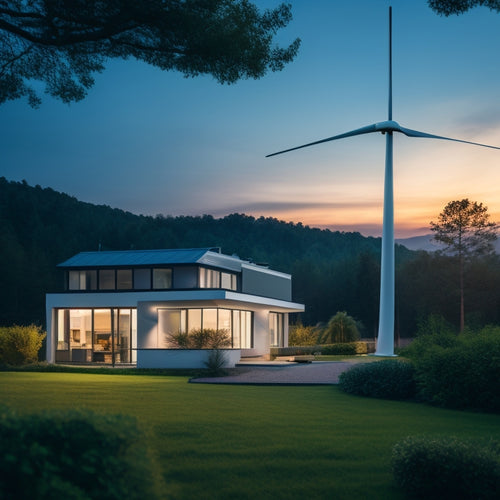
10 Best Cost-Effective Earth-Conscious Roofing Options for Homeowners
Share
As you investigate cost-effective earth-conscious roofing options, you'll find metal roofing, solar roofing, and cool roof coatings top the list for energy efficiency and cost savings. Recycled rubber roofing, green roofing with living plants, and eco-friendly clay tile roofing offer sustainable and environmentally friendly choices. Sustainable slate roofing alternatives, low-cost asphalt shingle options, and energy-saving roof insulation provide additional budget-friendly solutions. Environmentally friendly roof membranes and waste reduction strategies further minimize your ecological footprint. From enhancing energy independence to promoting biodiversity, these options can change your home - and now, you're just a step away from finding the perfect fit for your needs.
Key Takeaways
- Metal roofing reflects solar rays, reducing heat gain and energy consumption, while being 100% recyclable and cost-effective.
- Solar roofing enables energy independence, lowers energy bills, and increases property value, making it a sustainable and cost-saving option.
- Cool roof coatings mitigate urban heat island effect, reduce energy costs, and extend roof lifespan, providing a cost-effective eco-friendly solution.
- Eco-friendly clay tile roofing offers exceptional durability, low water absorption, and fire resistance, making it a sustainable and cost-effective option.
- Recycled rubber roofing reduces waste, conserves resources, and provides durability, making it a cost-effective and environmentally friendly choice.
Metal Roofing for Energy Efficiency
Metal roofing emerges as a top contender for energy efficiency, offering a unique combination of durability and eco-friendliness.
You'll appreciate the metal roofing benefits, including its ability to reflect solar rays, reducing heat gain in summer and heat loss in winter. This results in lower energy consumption and costs.
With various metal roofing styles to choose from, such as standing seam, corrugated, and metal shingles, you can select the one that suits your home's design and personal taste.
Moreover, metal roofing is 100% recyclable, making it an environmentally friendly option.
By integrating solar-powered fast charging infrastructure into your home's layout, you can additionally reduce your carbon footprint and energy reliance.
In addition, metal roofing's energy-efficient properties align with the growing trend of using renewable energy sources like wind and solar power.
Recycled Rubber Roofing Options
Sustainability takes center stage with recycled rubber roofing options, offering an innovative solution for eco-conscious homeowners. You can now enjoy the benefits of eco-friendly roofing without breaking the bank.
Recycled rubber roofing options are made from recycled materials, reducing waste and conserving natural resources. This eco-friendly solution also boasts impressive rubber durability, ensuring a long-lasting and low-maintenance roofing system.
Additionally, incorporating eco-friendly vehicle accessories, such as customizable and sustainable vehicle mats, can further reduce waste and promote a hygienic driving environment. By opting for recycled materials, homeowners can greatly minimize their environmental footprint.
- Water resistance: Recycled rubber roofing options are highly resistant to water, reducing the risk of leaks and water damage.
- UV resistance: These roofing options can withstand harsh UV rays, ensuring they remain durable and effective over time.
- Fire resistance: Recycled rubber roofing options are also fire-resistant, providing an added layer of safety for your home.
- Easy installation: These roofing options are relatively easy to install, reducing labor costs and installation time.
Green Roofing With Living Plants
While recycled rubber roofing options offer impressive eco-friendly benefits, you may be looking for an even more innovative way to reduce your environmental footprint. Green roofing with living plants is an attractive alternative that not only reduces stormwater runoff but also provides insulation and creates habitats for wildlife. When selecting plants for your green roof, consider factors like climate, maintenance, and weight capacity. Choose plants that are drought-tolerant and require minimal care.
| Plant Type | Benefits | Installation Tips |
|---|---|---|
| Sedum | Low maintenance, drought-tolerant | Use a sedum mat or plug plants 6-8 inches apart |
| Creeping Thyme | Fragrant, attracts pollinators | Plant 2-3 inches apart, water regularly during establishment |
| Wildflower Mix | Attracts wildlife, adds color | Sow seeds in fall or early spring, rake soil regularly |
| Succulent Mix | Low water requirements, varied textures | Plant 4-6 inches apart, water sparingly during hot months |
| Grasses | Oxygen production, erosion control | Plant 1-2 inches apart, maintain regular mowing schedule |
Solar Roofing for Homeowners
Your home's rooftop is prime real estate for capturing the sun's energy, and solar roofing offers a sleek, integrated solution. By incorporating solar panels into your roofing system, you can utilize the power of the sun to generate electricity and reduce your reliance on the grid.
With a solar panel installation, you'll enjoy:
-
Energy independence: Generate your own clean energy and reduce your dependence on fossil fuels. By future-proofing your home with sustainable energy solutions, you can adapt to regulations and consumer preferences renewable energy solutions.
-
Lower energy bills: Offset your energy consumption with free energy from the sun, which can also minimize outages for continuous operation and reliability.
-
Increased property value: A solar roofing system can elevate your home's value and appeal.
- Government incentives: Take advantage of tax credits and rebates for going solar.
Cool Roof Coatings Benefits
You'll find that cool roof coatings offer significant energy efficiency gains by reflecting solar rays and reducing heat absorption. This, in turn, helps mitigate the urban heat island effect, making your community a more comfortable place to live.
By integrating solar power, you can reduce grid reliance by up to 70% renewable energy integration, leading to significant cost savings and a cleaner environment.
Additionally, these coatings can extend your roof's lifespan by reducing thermal stress and weathering.
Energy Efficiency Gains
The building's roof, once a mere barrier against the elements, can now be a key player in reducing energy consumption thanks to cool roof coatings. You can maximize your roof's energy efficiency gains by choosing a coating that reflects solar radiation and emits heat quickly. This results in lower roof temperatures, reducing the need for air conditioning and conserving energy.
Regular maintenance, including cleaning and inspecting connections, is essential for optimizing performance and ensuring longevity, as regular cleaning of solar panels can prevent up to 20% efficiency loss solar panel efficiency. Achieving energy independence mitigates volatility in fuel prices and enhances operational efficiency through solar energy utilization.
-
Improved thermal performance: Cool roof coatings help reduce heat gain during summer and heat loss during winter, reducing the load on your HVAC system.
-
Increased energy savings: By reducing energy consumption, you'll lower your energy bills and rely less on non-renewable resources.
-
Extended roof lifespan: Cool roof coatings can help extend the life of your roof by reducing thermal stress and cracking.
- Contribution to a sustainable future: By optimizing your roof's energy efficiency, you're supporting the shift to renewable resources and a more sustainable future.
Reduced Urban Heat
By mitigating the urban heat island effect, cool roof coatings can greatly reduce the temperature of built environments, creating a more comfortable and healthy space for inhabitants. You'll appreciate the benefits of cool roof coatings, which not only reduce energy costs but also contribute to a more sustainable future.
| Heat Mitigation Method | Effectiveness | Benefits |
| Urban Greenery | 20-30% reduction in urban heat island effect | Improved air quality, reduced energy consumption |
| Cool Roof Coatings | 40-60% reduction in roof surface temperature | Reduced energy costs, increased roof lifespan |
| Green Roofs | 30-50% reduction in urban heat island effect | Improved air quality, habitat creation for wildlife |
| Urban Planning Strategies | 10-20% reduction in urban heat island effect | Improved public health, reduced heat-related illnesses |
| Tree Planting | 15-30% reduction in urban heat island effect | Improved air quality, reduced energy consumption |
Longer Roof Lifespan
Mitigating thermal stress on your roof through cool roof coatings can greatly extend its lifespan. By reducing the roof's temperature, you'll decrease the likelihood of cracks, fading, and other damage caused by thermal expansion and contraction.
This means you'll enjoy:
-
Fewer repairs: With a cooler roof, you'll have fewer issues to address, reducing your roof maintenance costs and hassle.
-
Less frequent replacements: By extending the life of your roof, you'll delay the need for a costly replacement, giving you more freedom to allocate your resources as you see fit.
-
Increased longevity benefits: A longer-lasting roof means you'll reap the benefits of your investment for a longer period, including energy savings and environmental benefits.
- Enhanced overall value: A well-maintained, long-lasting roof adds value to your property, giving you more freedom to make choices about your living situation.
Eco-Friendly Clay Tile Roofing
You're considering eco-friendly clay tile roofing as a cost-effective earth-conscious option.
Clay tiles are known for their exceptional durability, with lifespans often exceeding 50 years, which reduces the need for frequent replacements and waste generation.
Clay Tile Durability
Over a century of service life isn't uncommon for well-maintained clay tile roofs, with some reportedly lasting up to 150 years or more.
You can expect this level of durability when you invest in high-quality clay tile installation and commit to regular clay tile maintenance.
Here's what contributes to the exceptional longevity of clay tile roofs:
-
Resistance to weathering: Clay tiles are impervious to rain, hail, and extreme temperatures.
-
Low water absorption: Clay tiles absorb minimal water, reducing the risk of cracks and damage.
-
High compressive strength: Clay tiles can withstand heavy loads and pressure.
- Fire resistance: Clay tiles are non-combustible, providing an added layer of safety.
Environmental Impact Minimized
Most clay tile roofs require minimal maintenance and replacement, which substantially reduces the environmental impact of frequent roof replacements.
You'll be glad to know that eco-friendly clay tile roofing takes it a step further. Many modern clay tile manufacturers incorporate recycled materials into their production process, reducing waste and the demand on natural resources.
Additionally, sustainable practices are often employed throughout the entire lifecycle of the tile, from sourcing to disposal.
By choosing clay tile roofing, you're supporting an industry that's actively working to minimize its ecological footprint.
With a clay tile roof, you can enjoy a clear conscience and a reduced carbon footprint, all while protecting your home and the environment for generations to come.
Aesthetic Versatility Offered
Eco-friendly clay tile roofing offers unparalleled aesthetic versatility, allowing homeowners to tailor their roof's appearance to suit their unique style and design vision.
You can choose from a wide range of color options to match your home's exterior, from earthy tones to lively hues. Additionally, clay tiles can be molded into various shapes and sizes, providing design flexibility to accommodate different building styles.
Here are some ways clay tile roofing offers aesthetic versatility:
-
Variety of profiles: Clay tiles come in different profiles, such as flat, curved, or ribbed, to create a unique visual appeal.
-
Custom color options: You can choose from a palette of colors or create a custom color to match your home's exterior.
-
Mix-and-match designs: Combine different tile shapes, sizes, and colors to create a unique design that reflects your personal style.
- Pattern versatility: Create intricate patterns or simple designs using clay tiles to add visual interest to your roof.
Sustainable Slate Roofing Alternatives
While traditional slate roofing is renowned for its durability and aesthetic appeal, its high cost and environmental impact have driven the search for sustainable alternatives.
You can consider eco-friendly slate roofing alternatives that reduce waste and minimize environmental harm. Look for suppliers that prioritize responsible slate sourcing, ensuring that the material is extracted and processed with minimal ecological damage.
To extend the lifespan of your slate roof, follow essential maintenance tips such as regular inspections, debris removal, and prompt repair of damaged tiles.
Low-Cost Asphalt Shingle Options
As you weigh your roofing options, you may find that sustainable slate alternatives, though appealing, still exceed your budget.
Don't worry, there are affordable asphalt shingle options that can fit your needs. Asphalt shingles are a cost-effective solution that can provide a durable and weather-tight seal for your roof.
Here are some benefits of asphalt shingles:
-
Affordable materials: Asphalt shingles are one of the most budget-friendly roofing options available, making them an attractive choice for homeowners on a tight budget.
-
Easy installation: Asphalt shingles are relatively simple to install, which can reduce labor costs and get your roof up and running quickly.
-
Variety of styles: Asphalt shingles come in a range of styles and colors, allowing you to choose the perfect look for your home.
- Low maintenance: Asphalt shingles require minimal upkeep, freeing you from worrying about frequent repairs or replacements.
Energy-Saving Roof Insulation
When you're looking to maximize energy efficiency, you'll want to focus on heat retention strategies that keep warmth in during the winter and out during the summer.
You'll need to contemplate various insulation material options, such as fiberglass, cellulose, and spray foam, each with its own benefits and drawbacks.
Heat Retention Strategies
About 90% of a building's heat loss occurs through its roof, making energy-saving roof insulation a critical component of heat retention strategies.
As you consider your options, it's crucial to understand that heat retention isn't just about keeping warmth in, but also about keeping cold out.
You'll want to focus on reducing thermal bridging, which occurs when materials with high thermal conductivity come into contact, allowing heat to escape.
To achieve ideal heat retention, make sure to:
- Seal all gaps and cracks in your roof's envelope to prevent heat from escaping.
- Use continuous insulation to reduce thermal bridging.
- Optimize your roof's orientation to take advantage of passive heating from the sun.
- Select materials with low thermal conductivity to minimize heat loss.
Insulation Material Options
Your roof's insulation material selection plays a critical role in reducing heat loss and energy consumption.
You'll want to evaluate various insulation types that not only provide energy efficiency but also align with your eco-friendly goals. Eco-friendly options like recycled denim, wool, and cellulose insulation offer sustainable alternatives to traditional fiberglass.
Radiant barrier insulation, which reflects heat rather than absorbs it, is another option. You may also examine spray foam insulation, which provides high R-value and can be made from eco-friendly materials.
When selecting insulation, take into account factors like R-value, moisture resistance, and durability to guarantee peak performance and minimize environmental impact.
Environmentally Friendly Roof Membranes
Many modern buildings now incorporate environmentally friendly roof membranes, an essential component in reducing a structure's ecological footprint.
You can join the eco-friendly movement by choosing sustainable materials for your roof. Eco-friendly membranes are made from recycled materials, recyclable, or biodegradable, reducing waste and minimizing environmental impact.
When selecting an environmentally friendly roof membrane, consider the following:
-
TPO (Thermoplastic Polyolefin) membranes: made from recyclable materials, offering high durability and resistance to UV rays.
-
EPDM (Ethylene Propylene Diene Monomer) membranes: derived from recycled materials, providing excellent weather resistance and flexibility.
-
PVC (Polyvinyl Chloride) membranes: manufactured from recyclable materials, offering excellent durability and resistance to chemicals.
- Bituminous membranes: made from recycled asphalt, providing a cost-effective and eco-friendly option.
These eco-friendly membranes not only reduce your carbon footprint but also provide a durable and long-lasting roofing solution.
Frequently Asked Questions
Can I Install a New Roof Over an Existing One to Save Money?
You can install a new roof over an existing one, but it's essential to assess the condition of the old roofing materials and guarantee compatible installation methods to avoid potential issues and added costs down the line.
How Long Do Earth-Conscious Roofing Options Typically Last?
As you traverse the uncharted territory of eco-friendly roofs, you'll find that material durability and sustainability factors greatly impact lifespan, with options like metal and solar roofs lasting 30-50 years, and clay tiles up to 100 years, giving you the freedom to choose what's best for you.
Are There Any Government Incentives for Eco-Friendly Roofing?
You're eligible for government grants and tax credits when installing eco-friendly roofing, which can greatly offset costs; research federal and state programs, like the Solar Investment Tax Credit, to maximize your savings and environmental impact.
Can I DIY an Earth-Conscious Roofing Project to Save Money?
You can DIY an earth-conscious roofing project, but be prepared to invest time in researching and sourcing eco-friendly DIY materials and honing specialized roofing techniques, like installing solar shingles or living roofs, to guarantee a successful and cost-effective outcome.
Will an Earth-Conscious Roof Increase My Home's Resale Value?
Ha! You're wondering if going green will actually pay off when selling your pad? Absolutely! An earth-conscious roof made with sustainable materials and prioritizing energy efficiency will enhance your home's resale value, making it a hot commodity on the market, and lining your pockets with cash!
Related Posts
-

Why Merge Earth's Heat With Sun's Energy?
You're about to utilize the full potential of renewable energy by combining the Earth's natural heat with the Sun's a...
-

10 Grid-Tied Wind Power Systems for Modern Homes
You're looking for a grid-tied wind power system to utilize wind energy for your modern home. Here are ten options to...
-

What Water-Saving Gardens Complement Electric Vehicle Ownership?
As you pair your electric vehicle with a water-saving garden, you're not only reducing your carbon footprint but also...


